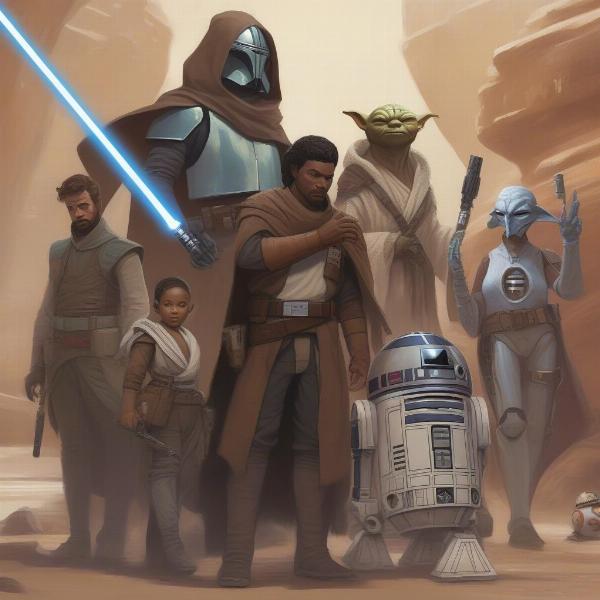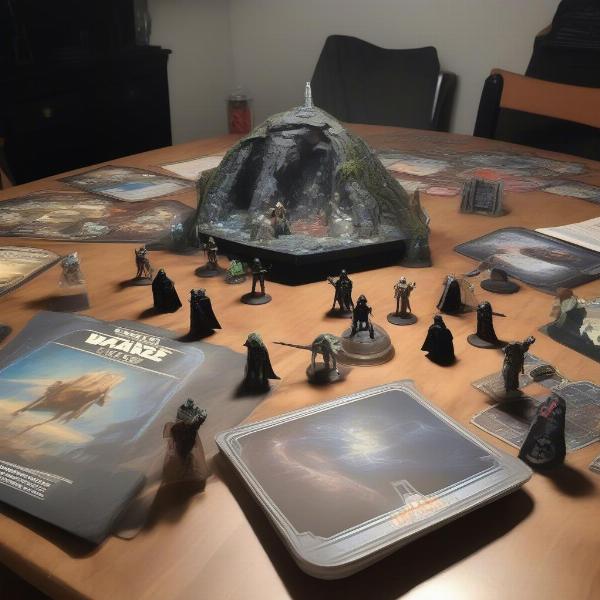This article delves into the different ways players and game masters can merge these two iconic franchises. We will explore homebrew rulesets, existing official content, and the key differences that separate the fantasy realms of D&D from the sci-fi narratives of Star Wars. By the end, you’ll be equipped to confidently navigate the hyperspace of a Star Wars D&D game, ready to create unforgettable stories of jedi, smugglers, and galactic conquest.
Why Merge Star Wars and D&D?
The appeal of a Star Wars D&D game is undeniable. Both franchises boast rich lore, compelling characters, and a focus on collaborative storytelling. Merging these two universes allows players to experience the thrill of Star Wars with the flexibility and depth of D&D’s role-playing system. You can go from a ragtag band of rebels fighting against the Empire, to a force of Jedi protecting the old republic. The possibilities are nearly endless.
The Allure of a Custom Universe
Many players find themselves drawn to the creative freedom offered by a homebrewed Star Wars D&D game. This approach allows for deep personalization, tailoring the rules and setting to match specific preferences. Players can implement their own force powers, create unique planets, and introduce original alien species, completely reshaping the familiar Star Wars universe. This level of customization is a big reason why so many enjoy the hybrid.
 star-wars-dnd-character-creation-showcasing-diversity
star-wars-dnd-character-creation-showcasing-diversity
The Benefits of Official Resources
While homebrewing offers limitless possibilities, official resources also provide invaluable tools for launching a Star Wars D&D game. The most well known is the Star Wars Roleplaying Game, which is not a true dnd system but is a great official resource. However, utilizing a pre-existing rule system like D&D 5e, offers a familiar foundation, allowing players to learn the core mechanics relatively quickly, allowing more time for fun role play. Plus, there are countless Star Wars conversion projects by fans that have done all the hard work for you.
Key Differences Between D&D and Star Wars
Understanding the fundamental differences between the high fantasy of D&D and the space opera of Star Wars is crucial for crafting an immersive gaming experience. Here are a few key areas to consider:
Magic vs. The Force
One of the most significant departures is the substitution of magic with the Force. D&D’s magic system, with its spells and distinct schools, doesn’t neatly translate to Star Wars’ more subtle and diverse Force abilities. Instead of spell slots, you will often see a simplified version of “force points” or something similar to represent the finite nature of a jedi’s power.
Technology & Gear
D&D’s focus is on medieval weaponry and armor, while Star Wars is driven by advanced technology, blasters, lightsabers, and spaceships. Adapting these elements is essential for creating an authentic Star Wars experience. Game Masters need to think carefully about how to translate these technologies into game mechanics. Will a lightsaber function as a magical great sword? What does a blaster rifle do damage-wise? These questions need careful thought.
Setting and Tone
The medieval fantasy setting of D&D is starkly different from the galactic scale of Star Wars. The tone is also quite different; D&D usually has a “medieval” feel, while Star Wars has more of a sci-fi feel. It’s important for Game Masters to carefully plan how these differing tones will affect the campaign and the world at large. Are you going for something more grim and gritty, like Rogue One, or light-hearted and swashbuckling, like the original trilogy?
What are the key challenges of adapting D&D to Star Wars?
Adapting D&D to Star Wars presents several interesting challenges. First, translating force powers to a D&D ruleset requires care and consideration to keep the game balanced. Second, accounting for the technological advancements of the Star Wars universe while maintaining a sense of fantasy. Finally, managing the unique setting and tone of Star Wars is key to the experience. “Finding a balance between the medieval and sci-fi themes is often the biggest hurdle in merging these worlds,” notes Dr. Aris Thorne, a renowned game design expert.
Building Your Star Wars D&D Game
Ready to jump into the cockpit and set course for adventure? Here are some steps to take to get your Star Wars D&D game running smoothly:
- Choose a Ruleset: Decide whether you will use a homebrew system, an official adaptation, or a modified version of D&D 5e. This decision will affect the mechanics of the game, from character creation to combat.
- Craft Your Setting: Define the era of your game; for example, the Old Republic, the Rise of the Empire, or the New Republic. Your choice will affect the availability of certain technologies, the overall tone, and the political landscape your players will navigate.
- Design Your Characters: Create archetypes that fit within the Star Wars universe. Players should have the freedom to build Jedi, smugglers, bounty hunters, or even droids. Make sure the characters have strong backstories that encourage roleplay.
- Adapt Items and Equipment: Convert Star Wars items such as blasters, lightsabers, and armor to fit the D&D framework. Ensure the power levels are balanced and the items feel appropriate for the setting.
- Implement the Force: Develop a system for implementing force powers, either using the D&D magic system as a base or creating something entirely new. Allow for both light and dark side abilities.
 star-wars-dnd-game-combat-scene-showing-player-interaction
star-wars-dnd-game-combat-scene-showing-player-interaction
What are some fun campaign ideas for a Star Wars D&D game?
The possibilities for campaigns in a Star Wars D&D game are vast. Here are some ideas to get you started:
- The Jedi Order’s Rebirth: Players take on the role of Jedi attempting to rebuild their order after the purge of Order 66.
- Smugglers in the Outer Rim: The group operates as a crew of smugglers, undertaking daring heists and navigating dangerous trade routes.
- The Galactic Civil War: The players find themselves caught in the middle of the rebellion, joining either the rebels or the empire.
- A Lost Artifact Quest: The party is tasked to retrieve ancient sith artifacts, hidden away since the Great Hyperspace War.
- Exploring Unknown Regions: The players venture into the unknown, encountering alien civilizations and forgotten secrets.
“Campaigns focusing on moral dilemmas and the consequences of choices often resonate deeply with players,” adds renowned game master, Elias Vane. “Star Wars, with its focus on good versus evil, is ripe with opportunities for such scenarios”.
How do you adapt D&D combat to Star Wars?
Adapting D&D combat to Star Wars requires careful consideration of the technological differences. The D&D combat system can be modified by:
- Replacing Melee Weapons: Convert the standard D&D weapons into lightsabers or other melee-based weapons.
- Introducing Ranged Combat: Add ranged combat with blasters, making use of cover mechanics and line-of-sight rules.
- Special Abilities: Develop unique abilities associated with the Force or advanced technology.
- Spaceship Combat: Adapt the rules to include encounters involving space battles between starfighters and capital ships.
Tips for Running an Immersive Game
Running a Star Wars D&D game requires more than just mechanics; it’s about crafting a story that resonates with the players. Here are a few extra tips:
- Embrace Role-Playing: Encourage players to fully immerse themselves in their characters, using Star Wars-specific dialogue and mannerisms.
- Use Descriptive Language: Paint vivid pictures of the Star Wars universe using rich descriptions of environments, characters, and technologies.
- Incorporate Sound and Music: Create an immersive atmosphere with a soundtrack inspired by the movies and sound effects that evoke the Star Wars feel.
- Use Familiar Elements: Incorporate familiar Star Wars characters, locations, and storylines to provide a sense of connection to the source material.
- Remember the Themes: A Star Wars game needs to include the core themes of good vs evil, personal redemption, and the value of hope.
 star-wars-dnd-game-table-setting-with-dice-and-miniatures
star-wars-dnd-game-table-setting-with-dice-and-miniatures
Conclusion
Merging the realms of Star Wars and D&D opens up a galaxy of possibilities for immersive storytelling and exciting gameplay. By understanding the key differences between the two universes and carefully planning your game, you can create a Star Wars D&D game that your players will be talking about for light years to come. Remember that SupremeDuelist.Blog is here to guide your journey into the endless possibilities of tabletop games. So, grab your dice, ignite your lightsaber, and may the Force be with you as you embark on your next epic adventure. Let us know how your game goes in the comments below.
Leave a Reply